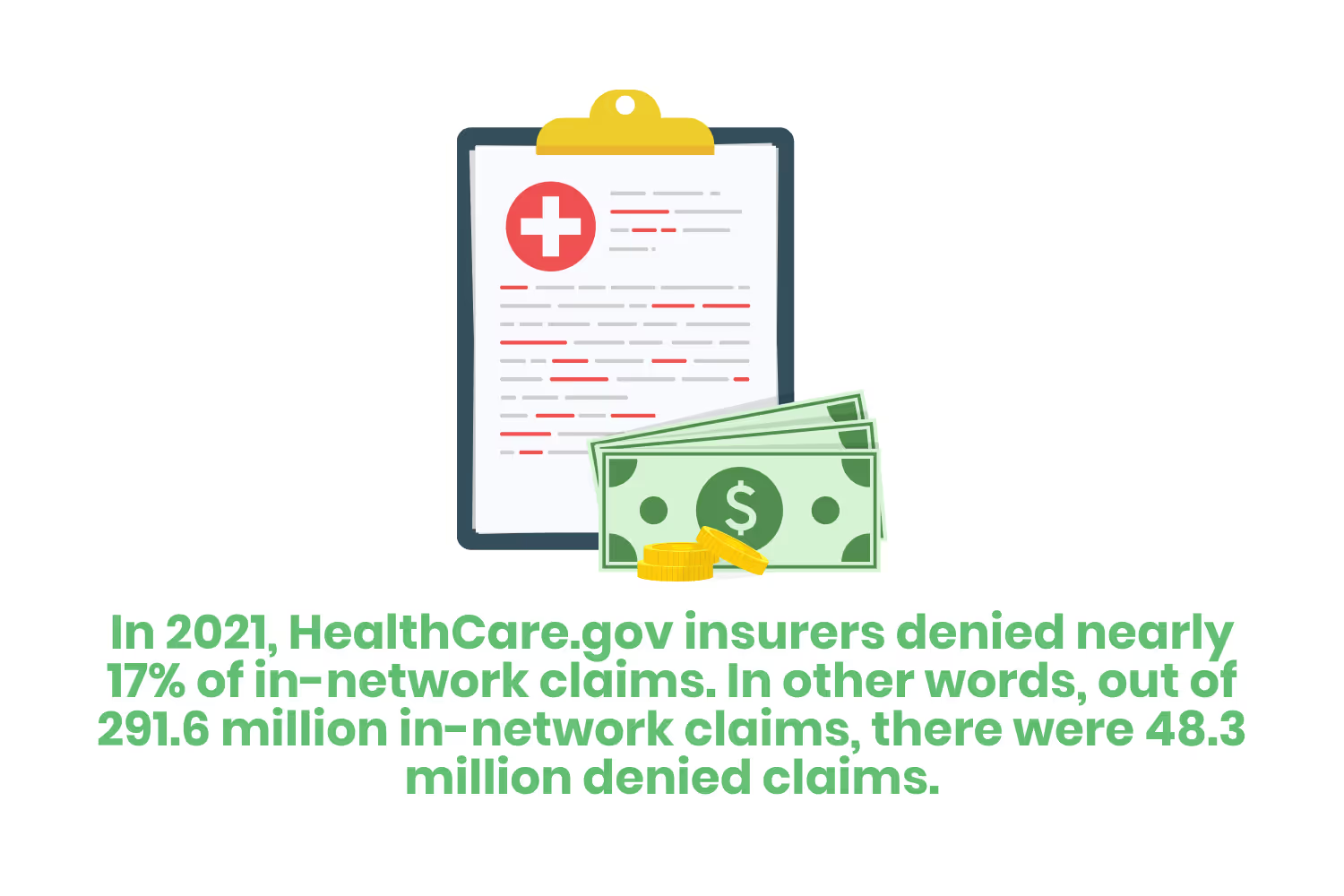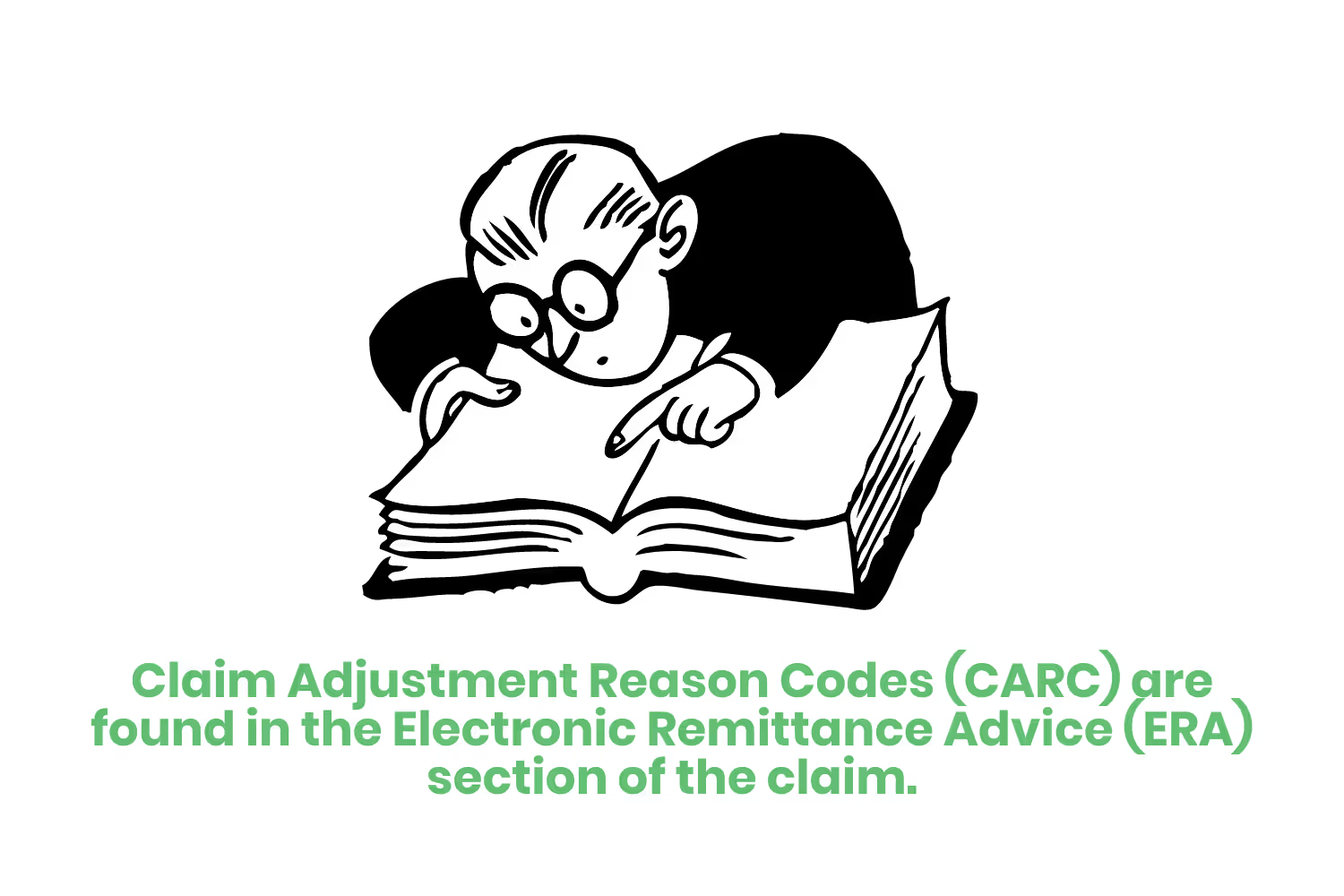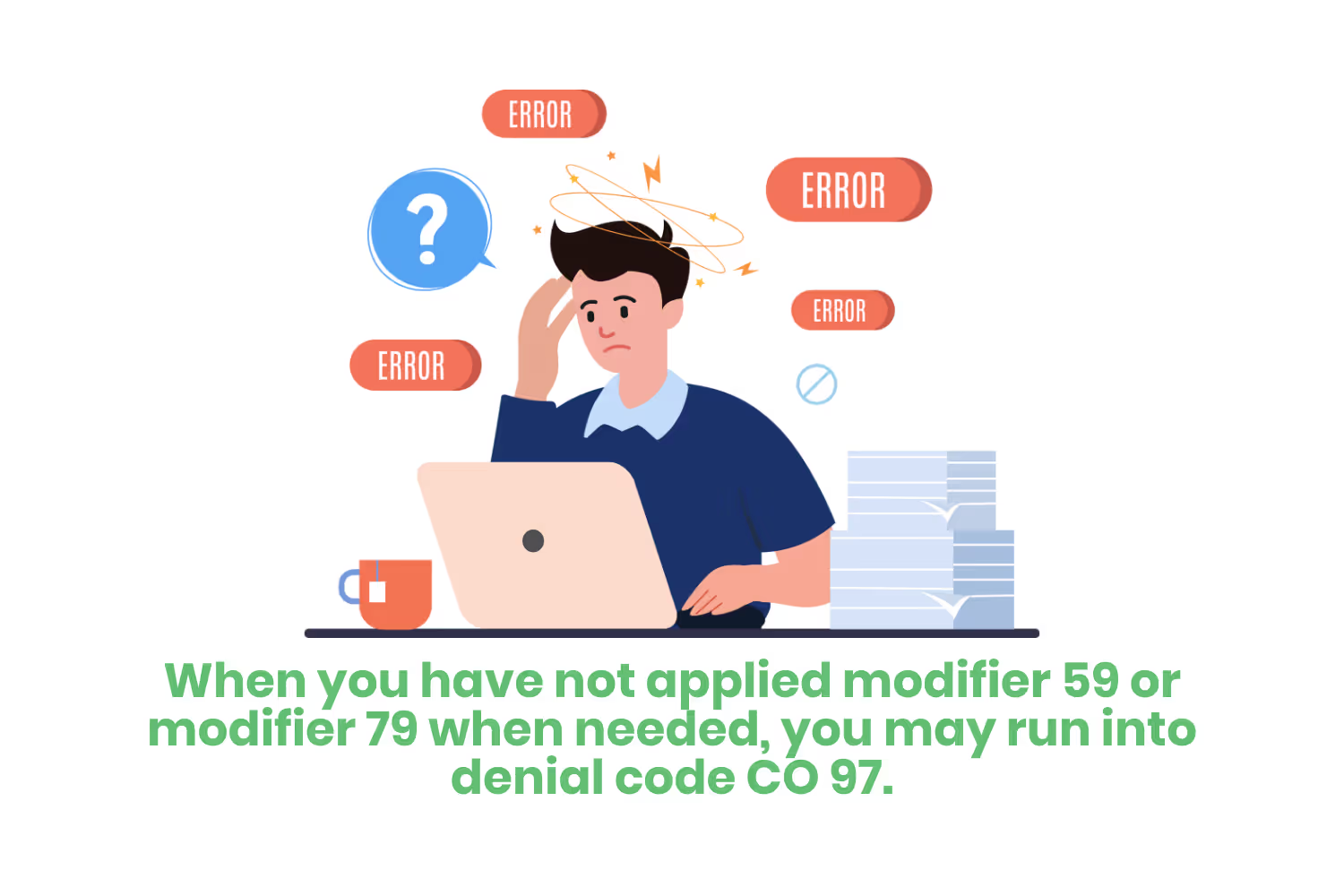Denial Code CO 97: An Ultimate Guide
In this series, we look at some of the most common denial codes. Today, let’s take a look at CO 97 and how understanding this code can save you money.

In 2021, HealthCare.gov insurers denied nearly 17% of in-network claims. In other words, out of 291.6 million in-network claims, there were 48.3 million denied claims. That’s a lot of lost revenue. Some insurers even report denying nearly half of in-network claims!
It’s no secret that claim denials are one of the most significant culprits for draining your practice’s resources, which leads to creating barriers to efficient revenue cycle management. Not only do denials hinder your team’s productivity, but they can also slow your organization's cash flow by delaying payments.

While you won’t be able to say sayonara to claim denials all together, you can minimize the amount your practice receives. To do this efficiently and effectively, it is important for you and your team to understand some of the most frequently seen denial codes.
In this series, we look at some of the most common denial codes. Today, let’s take a look at CO 97 and how understanding this code can save you money.
What Are Denial Codes?
As a medical coding expert, I’m sure when you submit your claim it always gets accepted. Right? Don’t worry, no one is THAT much of an expert. Like I said before, claim denials are a part of the game. Unfortunately, you won’t be able to avoid these.
But, what you can do is make sure the amount of claims that get denied stays at a low amount! So, let’s start with some lingo that you should learn to better understand how to navigate these denials. The most important being a ‘denial code’.
What is a denial code? I’m glad you asked. Denial codes are your biggest tools when tackling a denied claim. After all, how are you supposed to fix the claim for resubmission without knowing what is wrong with it?
Denial codes let you know exactly why an insurance company cannot accept your submitted claim. This of course can be due to all sorts of reasons, so understand that there are hundreds and hundreds of codes. Don’t worry, you won’t need to learn them all. But knowing at least the most common of them can save you a lot of hassle. It can also prevent you from making coding mistakes down the road.
Although there are hundreds of reasons why an insurance company may deny a claim, rest assured you only have to worry about one standard format to follow. This makes it easier on medical providers to stay up to date on codes, no matter which insurance they work with.
Claim Adjustment Reason Codes (CARC) are the name of this standardized template that insurance companies utilize when it comes to sending back claim denials. CARCs are helpful not only to explain why a claim gets denied but also any financial adjustments. If there are no adjustments to the claim, don’t expect there to be a CARC!

CARC descriptions are in the electronic remittance advice (ERA) section of the claim. As well as in the explanation of benefits (EOB).
Claim Adjustment Group Codes (CAGC) explain who is financially responsible for a claim balance.Two alphanumeric numbers represent these codes:
- Contractual Obligation (CO)
- Patient Responsibility (PR)
- Other Adjustment (OA)
- Patient Initiated Reduction (PI)
- Corrections and/or Reversal (CR)
Let’s take CO 97 for example. Because CO stands for “Contractual Obligation”, this means that the code is a contract between a healthcare provider and an insurance company. This is important for providers and insurance companies to figure out what services they will each be covering.
What is Denial Code CO 97?
Let’s get into the juicy details. Denial Code CO 97 occurs because the benefit for a service in the allowance/payment for another service that was already adjudicated. In simpler terms, the service or procedure is not paid for individually.
One example is when a provider bills a procedure code that is inclusive with another procedure code. If the same provider performs these procedures on the same day, this may cause a CO 97 code.

Here are a few more common examples of services that usually bundle with other services. The following are not separately payable:
- Taking a blood sample during the patient encounter.
- Transfer, conveyance, or handling of a specimen from the doctor’s office to the laboratory.
- Evaluation and management services done within the post-op period of a surgery that are directly related to that surgery. The time period for minor surgeries is usually 10 days. For major surgeries, it's usually 90 days.
- Using after-hour codes if your practice operates 24-hours daily.
How to Fix CO 97
On occasion, there are some solutions for denial code CO 97. That is because there are times when you bill services separately, even if they bundle with another service. Follow these steps to find out more:
- Check to see which procedure code is mutually exclusive, bundled, or included.
- Once you check for the procedure code, talk to the coding team. See if there is an appropriate modifier to use so you can resubmit the claim. They should be able to help you out.
- If the claim was already billed using the correct modifier, you still have the option to appeal the claim with support of medical records.
- Talking to the claims department can be useful to figure out further information that might be helpful in your appeal. Questions to ask include:
- When did we receive the claim?
- When was the claim denied?
- Which procedure code is mutually exclusive, inclusive, or bundled?
- Is there an appropriate modifier required? If yes, get the modifier and resubmit the claim as a corrected claim. If not, ask about the appeal limit so you can appeal the claim. Also, make sure to ask about the address and fax number for submission.
- Make sure you have the claim number and call reference number.
When you have not applied modifier 59 or modifier 79 when needed, you may also run into denial code CO 97. Let’s take a closer look at these modifiers and how they can help.
The Use of Appending Modifier 59 & 79
The Centers for Medicare & Medicaid Services states that you can’t report a service separately done at the same time as an additional procedure. So long as the service or procedure takes place in an anatomically related area using the same surgical approach.

But there’s a catch. If the procedure or service is distinct or unrelated to the major service, then you can code it separately. This is when modifier 59 becomes handy! Modifier 59 represents:
- A different patient encounter.
- Different Session.
- Different surgery or procedure.
- Different organ system or site.
- Separate lesions.
- Separate area or injury.
- Or separate excision/incision.
Let’s go over another exception and you guessed it… another modifier. Procedures performed during the postoperative period, unrelated to the original surgery, need modifier 79.
However, you will not be able to unbundle all procedures with the use of a modifier. You cannot unbundle code pair edits that have a “0” modifier indicator.
How to Avoid Future Denials
Avoiding denial code CO 97 isn’t always possible, but you can lower the likelihood of running into it by asking the right questions. Before you separately code a service or procedure, makes sure to ask these questions:
- Is this separate procedure or service a part of another major service or procedure?
- Is the separate procedure or service performed independently?
- Is the separate service or procedure unrelated to the major procedure or service?
- Is the separate procedure considered distinct?
- Is the separate procedure or service performed on the contralateral or ipsilateral side, same orifice/incision, and same organ?
If you answer yes to any of these questions, it may be possible to bill the service or procedure separately.
Conclusion
It has become a common trend among healthcare providers to outsource their claim management. Let’s face it, with nationwide staff shortages, a shifting economy, and lack of standardization among payers, there is no room for avoidable billing errors.
Employers know that a modernized experience is essential when it comes to working with patients and collecting revenue. Utilizing clearinghouses and claim scrubbing can help you instantly spot errors within your claims.
Helpful technology aside, learning about common denial codes is simply the best way to keep your practice’s bottom line safe. Equipping your team with the necessary tools to prevent denials will help you improve efficiency and give you a competitive edge in today’s professional climate.
Emphasize your product's unique features or benefits to differentiate it from competitors
In nec dictum adipiscing pharetra enim etiam scelerisque dolor purus ipsum egestas cursus vulputate arcu egestas ut eu sed mollis consectetur mattis pharetra curabitur et maecenas in mattis fames consectetur ipsum quis risus mauris aliquam ornare nisl purus at ipsum nulla accumsan consectetur vestibulum suspendisse aliquam condimentum scelerisque lacinia pellentesque vestibulum condimentum turpis ligula pharetra dictum sapien facilisis sapien at sagittis et cursus congue.
- Pharetra curabitur et maecenas in mattis fames consectetur ipsum quis risus.
- Justo urna nisi auctor consequat consectetur dolor lectus blandit.
- Eget egestas volutpat lacinia vestibulum vitae mattis hendrerit.
- Ornare elit odio tellus orci bibendum dictum id sem congue enim amet diam.
Incorporate statistics or specific numbers to highlight the effectiveness or popularity of your offering
Convallis pellentesque ullamcorper sapien sed tristique fermentum proin amet quam tincidunt feugiat vitae neque quisque odio ut pellentesque ac mauris eget lectus. Pretium arcu turpis lacus sapien sit at eu sapien duis magna nunc nibh nam non ut nibh ultrices ultrices elementum egestas enim nisl sed cursus pellentesque sit dignissim enim euismod sit et convallis sed pelis viverra quam at nisl sit pharetra enim nisl nec vestibulum posuere in volutpat sed blandit neque risus.

Use time-sensitive language to encourage immediate action, such as "Limited Time Offer
Feugiat vitae neque quisque odio ut pellentesque ac mauris eget lectus. Pretium arcu turpis lacus sapien sit at eu sapien duis magna nunc nibh nam non ut nibh ultrices ultrices elementum egestas enim nisl sed cursus pellentesque sit dignissim enim euismod sit et convallis sed pelis viverra quam at nisl sit pharetra enim nisl nec vestibulum posuere in volutpat sed blandit neque risus.
- Pharetra curabitur et maecenas in mattis fames consectetur ipsum quis risus.
- Justo urna nisi auctor consequat consectetur dolor lectus blandit.
- Eget egestas volutpat lacinia vestibulum vitae mattis hendrerit.
- Ornare elit odio tellus orci bibendum dictum id sem congue enim amet diam.
Address customer pain points directly by showing how your product solves their problems
Feugiat vitae neque quisque odio ut pellentesque ac mauris eget lectus. Pretium arcu turpis lacus sapien sit at eu sapien duis magna nunc nibh nam non ut nibh ultrices ultrices elementum egestas enim nisl sed cursus pellentesque sit dignissim enim euismod sit et convallis sed pelis viverra quam at nisl sit pharetra enim nisl nec vestibulum posuere in volutpat sed blandit neque risus.
Vel etiam vel amet aenean eget in habitasse nunc duis tellus sem turpis risus aliquam ac volutpat tellus eu faucibus ullamcorper.
Tailor titles to your ideal customer segment using phrases like "Designed for Busy Professionals
Sed pretium id nibh id sit felis vitae volutpat volutpat adipiscing at sodales neque lectus mi phasellus commodo at elit suspendisse ornare faucibus lectus purus viverra in nec aliquet commodo et sed sed nisi tempor mi pellentesque arcu viverra pretium duis enim vulputate dignissim etiam ultrices vitae neque urna proin nibh diam turpis augue lacus.




